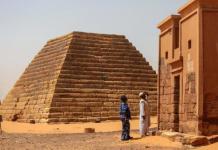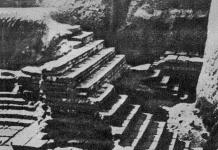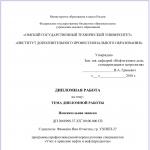The first ziggurat on the site of E-temenanka was erected during the time of King Hammurabi (17th century BC). Its adobe masonry has been restored several times. In 689 BC. e. Babylon was captured by the soldiers of the Assyrian king Sennacherib, who “destroyed the city walls and its houses, temples and gods, the temple tower made of sand and clay... destroyed and threw into the Arakhtu canal...”. The sanctuary of Esagila and the ziggurat were restored fifteen years later by the Assyrian architect Aradahheshu, and under Nebuchadnezzar II the grandiose construction came to an end. As cuneiform tablets testify, the king himself participated in the construction of the Tower, lifting baskets of bricks to the top (Fig. 8.13).

Rice. 8.13. Ruins of the city and the Tower of Babel
The ziggurat had seven tiers. According to R. Koldewey, it had a square base, each side of which was 90 meters. The height of the tower was also 90 meters, the first tier had a height of 33 meters, the second - 18, the third and fifth - 6 meters each, the seventh - the sanctuary of the god Marduk - was 15 meters high. The topmost tier of the tower was lined with blue tiles and covered with gold.
Herodotus believed that the dimensions of its base were 185x85 meters. Strabo, who found the ziggurat already destroyed, was sure that its height of 90 fathoms “surpassed even the Egyptian pyramids.” The inner core of the E-temenanka consisted of adobe brick, the facing was made of baked bricks (32x32 cm), laid on bitumen (Fig. 8.14). The tower stood on the plain of Sahn ( "Pan") on the left bank of the Euphrates. It was surrounded by the houses of priests, temple buildings and houses for pilgrims who flocked here from all over Babylonia. A description of the Tower of Babel was left by Herodotus, who thoroughly examined it and, perhaps, even visited its top. This is the only documented description of an eyewitness from Ancient Greece:
“In the middle of every part of the city a building has been erected. In one part is the royal palace, surrounded by a huge and strong wall; in the other there is the sanctuary of Zeus-Bel with copper gates that have survived to this day. The temple sacred area is quadrangular, each side two stages long. In the middle of this temple sacred site was erected a huge tower, one stade long and wide. On this tower stands a second one, and on it another tower; in general, eight towers - one on top of the other. An external staircase leads up around all these towers. In the middle of the stairs there are benches - probably for rest. A large temple was erected on the last tower. In this temple there is a large, luxuriously decorated bed and next to it a golden table. However, there is no image of a deity there. And not a single person spends the night here, with the exception of one woman, whom, according to the Chaldeans, the priests of this god, God chooses from all the local women. These priests claim (I don’t believe this, however) that God himself sometimes visits the temple and spends the night on this bed...”[Herodotus,I, 181] .
“Here is also the tomb of Bel, now destroyed; as they say, it was torn down by Xerxes. It was a quadrangular pyramid, built of baked brick, a stade high, just as each side was a stade long...” [Strabo,XVI, 1, 5] .
According to Koldewey’s descriptions, the tower was one tier lower, and the lower tier was 90 meters wide, that is, half as much. Perhaps, in the time of Herodotus, the tower stood on some kind of terrace, albeit a low one, which over the millennia was leveled to the ground, and during excavations Koldewey did not find any trace of it.
Each large Babylonian city had its own ziggurat, but none of them could compare with the Tower of Babel, which towered over the entire area like a colossal pyramid. It took 85 million bricks to build, and entire generations of rulers built the Tower of Babel. The Babylonian ziggurat was destroyed several times, but each time it was restored and decorated anew. The ziggurat was a shrine that belonged to the entire people, it was a place where thousands of people flocked to worship the supreme deity Marduk.
Cyrus, who took control of Babylon after the death of Nebuchadnezzar, was the first conqueror to leave the city undestroyed. He was struck by the scale of E-temenanka, and he not only forbade the destruction of anything, but ordered the construction of a monument on his grave in the form of a miniature ziggurat, a small Tower of Babel.
And yet the tower was destroyed again. The Persian king Xerxes left only ruins of it, which Alexander the Great saw on his way to India. He was also amazed by the gigantic ruins - he also stood in front of them as if spellbound:
“Alexander wanted to restore this pyramid; however, this required a lot of labor and a long time (clearing the garbage alone would have taken 10,000 people for two months), so the king did not have time to complete the enterprise, as he was soon beset by illness and death. None of his successors cared about this..." [Strabo,XVI, 1, 5] .

Rice. 8.14. Reconstruction of the Tower of Babel – painting by P. Bruegel the Elder (1563)
Dissected on each side by 12 wide blades, the walls were, unlike earlier ziggurats, strictly vertical. The two lower tiers, divided by blades, were much higher than the rest. Adjacent to the southern wall were three staircases leading to the first terrace (as at Ur). The second terrace was reached by stairs adjacent to the eastern and western walls. Further movement had to go in a spiral, but not along a ramp, as in Dur-Sharrukin, but along the stairs.
The top of the ziggurat - the temple - was lined with blue tiles and crowned with huge golden horns dedicated to the god Marduk and his wife, the goddess of the dawn Tsarpanit (Ishtar). The ascent to the tiers was done from outside. It walked in a spiral around all the towers. Only priests could enter the god's dwelling. Inside the temple there was a huge golden bed for the god and a table for laying donations. A huge lamp in the form of a solar disk was suspended from the ceiling of the sanctuary (Fig. 8.17).


Rice. 8.15. Options for the reconstruction of the Tower of Babel according to L. Woolley and G. Martini (1923)


Rice. 8.16. Reconstruction options for the Tower of Babel. Above is the modern version (Germany),
below - according to T. Dombart (1930)

Rice. 8.17. Image of the god Shamash. Relief (according to Chipier and Perrault)
There are very different versions regarding the number and color scheme of tiers in this ziggurat. However, most researchers agree that the number of tiers was equal to 7: according to the number of planets and celestial bodies known at that time; by the number of days in a week (lunar calendar); in accordance with the Babylonian version of the “model of the Universe”.
In any case, the seven-tiered ziggurat symbolized the political and religious union of the seven main cities of the Babylonian federation (Borsippa, Babylon, Kish, Kuta, Sippar, Ur and Uruk). Two options for interpreting the color symbolism of the Tower of Babel are shown in tables 1-2.
Table 1
|
Tier color |
Planet, luminary |
Day of the week | |||
|
Sunday | |||||
|
Mercury |
Borsippa |
||||
|
Monday |
table 2
|
Tier color |
Planet, luminary |
Day of the week | |||
|
Sunday | |||||
|
Monday | |||||
|
Mercury |
Borsippa |
||||
Observations of the stars were carried out from the site in front of the temple - “Mountain Heights”. There were astronomical instruments and instruments here - a sighting device, solar and water chronometers, etc. It is quite possible that the huge horns on the roof of the temple served as sights, with the help of which they determined the position of celestial bodies at different times of the day.
One of the largest civilizations of antiquity originated in Mesopotamia. Many centuries ago, the first people here began to build their houses and temples. The main material for construction in Mesopotamia was raw brick. Everything was built from clay here: from the central temple and the surrounding houses of the residents, to the walls of the city.
Ziggurats in ancient Mesopotamia
Temples in Mesopotamia were built on a stone platform. Over time, this technology grew into the construction of huge ziggurats, known to us from the structures at Ur and Babylon. The ziggurat is a large tower with multi-tiered protruding terraces. By reducing the area of the higher blocks, the impression of several towers is created. The number of such ascents reached up to seven, but usually stayed around four. It was a tradition to paint different levels in different colors - black, brick, white, etc. In addition to painting, landscaping was carried out on the terraces, which further distinguished the building from the general background. Sometimes the dome of the temple building, located at the very top, was made gilded.

Reconstruction
Sumerian ziggurats are similar to Egyptian pyramids. They are also a kind of staircase to heaven, only the ascent here is gradual, level-by-level, and not like in the famous tombs of the pharaohs.

Ziggurats of Mesopotamia and pyramids of Egypt
The top of the ziggurat was decorated with a sanctuary, the entrance to which was closed to the ordinary visitor. The decoration of the god's home was modest; there was usually only a bed and a table made of gold. Sometimes priests climbed to the top of the building to carry out important astronomical observations aimed at predicting the agricultural life of the country. It is believed that it was here that modern astrology, the names of constellations and even the signs of the Zodiac originated.
The Great Ziggurat of Ur - Preserved for Millennia
One of the most famous ziggurats that has survived to this day is the famous ziggurat of Etemenniguru at Ur.

History of the ziggurat
The city of Ur itself has been famous since time immemorial. It was here, according to biblical teaching, that the father of many nations, Abraham, was born. In 2112-2015 BC, during the reign of the III dynasty, Ur entered the peak of its power, and it was during this period that the founder of the dynasty, King Urnammu, with his son Shulgi, took on the task of creating the great appearance of the city.
On his initiative, around 2047 BC, in honor of the patron saint of the city, the moon god Nanna, a ziggurat was created, in no way inferior in size to the Tower of Babel.
The three-tier building has survived to this day in good shape. Since the middle of the 19th century, this hill has been actively studied. The first explorer of the ziggurat at Ur was the Englishman of Basra, D. E. Taylor. In the brickwork he discovered cuneiform writing about the construction of this structure. It turned out that the construction of the ziggurat, which began under King Urnamma, was not completed, and only the last king of Babylon, Nabonidus, in the 550s BC, was able to put an end to this long-term construction. He also increased the number of tiers from three to seven.

Description of the ziggurat
After a thorough study of the structure, archaeologists in 1933 created a probable reconstruction of the ziggurat of the moon god Nanna at Ur. The tower was a three-tiered pyramid. Built from raw brick, the outside of the ziggurat was lined with baked brick. The cladding in some places reaches a thickness of 2.5 meters. The base of the pyramid has the shape of a rectangle with sides 60 by 45 meters. The height of the first tier is about 15 meters. The upper tiers were slightly smaller, and on the upper terrace was the temple of Nanna. The terraces were painted: the lower one was black, the middle one was red, the upper one was white. The total height of the giant exceeded 53 meters.

To reach the top, three long and wide staircases of 100 steps each were built. One of them was located perpendicular to the ziggurat, the other two rose along the walls. From the side staircases one could go to any of the terraces.
When carrying out calculations, researchers encountered inconsistencies. As it turned out later, the Mesopotamian masters made the walls deliberately crooked to create the illusion of height and power of the building. The walls were not just curved and inclined inward, but carefully calculated and convex, which further proves the very high level of construction in Mesopotamia. Such architecture involuntarily forces the eye to rise upward and focus on the central point - the temple.
Of particular interest are the deep-cut slits in the wall. They are empty on the outside, but inside they are filled with clay shards. It was found that a similar solution was used to drain the inside of the building so that the brick would not swell from moisture.
All that remained was to understand where the moisture inside the ziggurat came from. During the construction of the ziggurat, the brick had time to dry out, so this version was quickly cut off. During the excavations, special grooves were found designed to drain water downwards, which meant that there was water on the terraces.
One of the tablets found here told about the clearing of the littered temple of the moon goddess “Gigpark”, located near one of the walls of the ziggurat, from tree branches. The idea arose that the branches could only get there from the ziggurat, and this explains the water drainage system. The terraces were covered with soil on which plants and those same trees grew. Here we can draw an analogy with the built hanging gardens of Babylon in Babylon. So the drainage system could also be used to irrigate temple plantations, and drainage holes were used to reduce the effect of moisture on the building itself.
The Tower of Babel has not survived to this day, so to represent it it is worth paying attention to the ziggurat at Ur. He, of course, suffered from time. But what remains of it makes us once again surprised by the aspirations of the people of antiquity.
Mesopotamia became the oldest post-Flood civilization. It is interesting that the Bible, which contains a wealth of information about many kingdoms, first talks about Babylon, giving it a large place both in the historical and prophetic aspects. As is clear from the Holy Scriptures and ancient chronicles, the very first steps in the formation of Mesopotamian statehood were inextricably linked with religion, which was based on an open challenge to the true God, which was most clearly manifested in the construction of the famous Tower of Babel. Today, no one doubts its existence, which has been proven by historians and archaeologists.
But before we move on to history, architecture in the religious significance of its construction, let’s pay attention to the creation of special ziggurat temples, to which the famous tower belonged. So, the ziggurat was a huge structure consisting of several towers (usually from 4 to 7), located one on top of the other, proportionally decreasing towards the top. Between the top of the lower tower and the base of the one above, terraces with beautiful gardens were laid out. At the top of the entire building stood a sanctuary, to which a huge staircase led, starting at the bottom and having several side branches. This upper temple was dedicated to some deity who was considered the patron saint of this city.
The towers themselves were painted in different colors: the lower one, as a rule, was black, the second - red, higher - white, even higher - blue, etc. The upper tower was often crowned with a golden dome, which was visible many kilometers from the city . From a distance this sight was truly fabulous. However, the ziggurat was something more than just a temple; it was a link between heaven and earth, as well as a place where God himself supposedly appeared, declaring his will to people through the priests. But if during the day the ziggurat was a temple, then at night it was a place of astrological actions, as well as a place for performing black satanic rituals.
We will never fully know all the details of the departure of these services, but even the information that clay tablets tell us is terrifying. It was in the upper temples that astrology was created, connecting people with the abyss. During the excavations, it was established that the name of its founder was Saaben ben Aares, however, the true creator of this pseudoscience was, of course, the prince of darkness.
Such ziggurats were built in Nippur (about 2100 BC by King Ur-Nammu), now located 40 miles west of the Euphrates; at Uruk, 12 miles from the Euphrates, covering an area of 988 acres; in Eridu, erected almost immediately after the flood and renovated many times throughout history, forming 12 temples located one above the other; Ure - also built by King Ur-Nammu in honor of the moon god Nanna, and very well preserved to this day, etc. But the most famous was the ziggurat built in Babylon at the dawn of post-Flood history, described in the Bible. “The whole earth had one language and one dialect. Moving from the east, the people found a plain in the land of Shinar and settled there. And they said to each other: Let us make bricks and burn them with fire. And they used bricks instead of stones, and earthen resin instead of lime.
And they said: Let us build ourselves a city and a tower, its height reaching to heaven; and let us make a name for ourselves, before we are scattered over the face of all the earth” (Gen. 11:1-4). The terrible punishment that befell humanity, which decided to follow its own path, independent of God and contrary to His will (the flood), was forgotten. People again chose to live and act without God for the sake of satisfying their vanity and pride. God could not approve of their proud and insane plan, and, by confusing languages, prevented the fulfillment of human plans. However, not wanting to humble themselves before the Creator, people again soon began building a ziggurat in the same place where it was stopped by God Himself.
Jesus Christ never does violence to human free will, and therefore He did not interfere with this crazy plan of people, wanting them and their descendants to see what their open and persistent disobedience to Heavenly Father would lead to. With pain, Christ watched as people stubbornly built a tower, which was supposed to become the center of worship of false gods, in other words, they built a scaffold for themselves. For the religion that they so defended and propagated was supposed to lead them to degradation and death. But the arrogant builders, besotted by the prince of darkness, did not think about this, and finally built a majestic structure that amazed people with its beauty and scope for 1500 years. The Babylonian ziggurat, rebuilt dozens of times during this time, was called Etemenanka, that is, the Temple of the Cornerstone of Heaven and Earth, being the center of the colossal temple city of Esagila (House of Raising the Head), surrounded by fortified walls and towers, including many temples and palaces. Esagila was the seat of the main Babylonian priest, who was at the same time the high priest of the entire world priesthood (this will be discussed below).
Descriptions of this tower by the famous Greek historian Herodotus and the personal physician of the Medo-Persian king Artaxerxes II - Ctesias - have reached our time. The tower they described was restored under Nabopolassar (625-605 BC) and Nebuchadnezzar II (605-562 BC) after a period of decline. Rebuilding the tower, Nebuchadnezzar said: “I had a hand in completing the top of Etemenanka so that it could compete with the sky.” So, the tower they built consisted of seven steps - floors. The first floor, 33 meters high, was black and was called the lower temple of Marduk (the supreme god of Babylon); in its center stood a statue of the god, completely cast from the purest gold and weighing 23,700 kilograms!
In addition, the temple contained a golden table 16 meters long and 5 meters wide, a golden bench and a throne. Daily sacrifices were made in front of the statue of Marduk. The red second floor was 18 meters high; the third, fourth, fifth and sixth are 6 meters high and were painted in various bright colors. The last seventh floor was called the upper temple of Marduk, was 15 meters high and was lined with turquoise glazed tiles decorated with golden horns. The upper temple was visible many kilometers from the city and in the light of the sun it was a sight of extraordinary beauty. In this temple there was a bed, an armchair and a table, supposedly intended for God himself when he came here to rest.
The “sacred” marriage of the king and the priestess also took place there, all this was accompanied by an orgy, enclosed in a “sublime” philosophy. Today the ziggurats lie in ruins, and many have not survived at all, but the ideas of their builders continue to live today. So, firstly, the construction of the ziggurat was, as we have already said, in the nature of an open challenge to divine authority. Even the name Etemenanka challenges Christ by appropriating His title, for the Scripture says: “...behold, I lay in Zion a cornerstone, chosen and precious: and he who believes in Him will not be put to shame” (1 Peter 2:6). Many peoples of the earth followed this example, building pagan temples and temple complexes that went into the clouds. From recent times, it is worth noting the construction of the 30s, begun under Stalin (but not completed!) - the Palace of Congresses, which was supposed to be crowned with a figure of Lenin of such a size that in one finger, according to the architects, two libraries and a cinema would be located . This palace was supposed to become a symbol of militant atheism, which supposedly defeated “outdated” Christianity, and the leader, of course, was supposed to appear before the world as the “victor” of Christ!
The fate of this plan and the construction that began is known. But even unrealized, this project stands on a par with the Tower of Babel, the Temple of Artemis of Ephesus and other “witnesses” warning us, people of the late 20th century, about the danger of a path separated from God. Secondly, the construction of ziggurats was a symbol of human power, a glorification of the human mind.
And again, reading the pages of history, we see attempts to glorify and magnify our name at different times and among different rulers - kings, emperors, prime ministers, presidents, general secretaries, philosophers, scientists and artists, etc. An endless list of names that can be continue and continue - Cyrus, Nebuchadnezzar, Macedonian, Octavian-Augustus, Nero, Trajan, Charles V of Germany, Napoleon, Lenin, Hitler, Stalin; philosophers Rousseau, Voltaire, Montesquieu, who idolized the human mind and prepared the Great French Revolution with their ideas; Darwin with his theory of evolution, the ideologists of fascism and communism, who also tried to build heaven on earth without God at the cost of millions of victims. This is where you and I can be, if in our lives we rely on our own selves, exalt ourselves, and not Jesus Christ. Thirdly, the construction of ziggurats showed that a person can reach the sky himself, become like God, for the tower connected heaven and earth in the minds of people. This idea is extremely tenacious, for even today many confessions claim that a person, through his deeds and the performance of certain rituals, can achieve salvation and eternal life himself, on his own.
Fourthly, the service of the priests in the ziggurat showed that between heaven and earth a mediator was needed, capable of appeasing the formidable god. It is from here that the teachings about holy mediators between God and people, about clergy as intercessors before God, originate. However, all of these statements contradict the Bible, which states: “For there is one God, and one mediator between God and men... Christ Jesus” (1 Tim. 2:5). Fifthly, the ziggurat was the center of astrology, magic, and the occult, which have found enormous and growing popularity in our time.
We will talk about them in detail in another part of this book, but now we will note only the main thing: the very idea underlying astrology, namely predicting fate and ways to influence it, nullifies faith in God. Sixthly, the luxurious architecture of the tower and the majestic, mysterious services, incomprehensible to ordinary people, held in the temple, were intended to bewitch and subjugate the feelings and mind of a person, paralyze his will, and deprive him of the freedom of reasonable choice. The same technique was later used by almost all world religions in the construction of huge cathedrals with rich frescoes, statues, paintings, and many hours of tedious services, often in languages incomprehensible to most people. How different this is from the ministry, the example of which Jesus Christ gave during His earthly life, carried out in the lap of nature, in humble homes! So, as we see, the ideas of the ancient ziggurats continue to live today. It is not for nothing that in the Bible, one of the prophecies of which we partially cited in the epigraph to this chapter, the apostate forces are called Babylon
A ziggurat (from the Babylonian word sigguratu - “peak”, including “top of a mountain”) is a multi-stage religious structure in ancient Mesopotamia, typical of Sumerian, Assyrian, Babylonian and Elamite architecture.
Story
A ziggurat is a tower of parallelepipeds or truncated pyramids placed on top of each other from 3 among the Sumerians to 7 among the Babylonians, which did not have an interior (with the exception of the upper volume in which the sanctuary was located). The ziggurat's terraces, painted in different colors, were connected by stairs or ramps, and the walls were divided by rectangular niches. Inside the walls supporting platforms (parallelepipeds) there were many rooms where priests and temple workers lived.
Next to the stepped ziggurat tower there was usually a temple, which was not a prayer building as such, but the dwelling of a god. The Sumerians, and after them the Assyrians and Babylonians, worshiped their gods on the tops of the mountains and, preserving this tradition after moving to the lowlands of Mesopotamia, erected mound mountains that connected heaven and earth. The material for the construction of ziggurats was raw brick, additionally reinforced with layers of reeds, and the outside was lined with baked bricks. Rains and winds destroyed these structures, they were periodically renovated and restored, so over time they became taller and larger in size, and their design also changed. The Sumerians built them in three stages in honor of the supreme trinity of their pantheon - the god of air Enlil, the god of water Enki and the god of sky Anu. The Babylonian ziggurats were already seven-tiered and painted in the symbolic colors of the planets (five planets were known in ancient Babylon): black (Saturn, Ninurta), white (Mercury, Nabu), purple (Venus, Ishtar), blue (Jupiter, Marduk), bright -red (Mars, Nergal), silver (Moon, Sin) and gold (Sun, Shamash) [source not specified 840 days].
Dur-Untash or Chogha-Zanbil, built in the 13th century BC. e. Untash Napirisha and located near Susa, one of the best preserved ziggurats
In the later period, the ziggurat was not so much a temple structure as an administrative center where the administration and archives were located.
The prototype of the ziggurat were stepped temples. The first such towers in the form of primitive stepped terraces appeared in the alluvial valleys of the Tigris and Euphrates at the end of the 4th millennium BC. e. The last noticeable surge in activity in the construction of Mesopotamian ziggurats is attested already in the 6th century BC. e., at the end of the Neo-Babylonian period. Throughout ancient history, ziggurats were renovated and rebuilt, becoming a source of pride for kings.
Babylonian ziggurat. Was there a tower?
Try a simple experiment: ask someone to list the seven wonders of the world. Most likely, they will first name you the Egyptian pyramids. Then they will remember the Hanging Gardens of Babylon and will almost certainly name the Tower of Babel. And they will be wrong. There was no Tower of Babel. The Bible says that construction began on the tower, but the construction management was unable to find the required number of translators, and due to language barriers, the work was interrupted.
All this is true. If, of course, you believe the Bible.
Well, what if you don’t believe it? If you try to find out what really happened there in Babylon?
First, let's turn the pages of history and see how people imagined this mysterious Tower of Babel, how its image gradually changed...
The earliest surviving image of the Tower of Babel is preserved in a bas-relief in the Cathedral of Salerno, in southern Italy. It dates back to the 11th century. It depicts a small, twice the height of a man, rectangular structure, similar to an unfinished European fortress tower. Two people from below handed a bowl with a solution, and the third, who barely fit on the upper platform, stretched out his hands to accept this bowl. And to the left of the tower, which is as tall as she is - the builders only reach him up to his waist - stands God himself. He edifyingly extended his hand towards the tower. The author of the bas-relief did not have much imagination. He left it to the spectators, who had to believe that because of such a nondescript structure, the Babylonian pandemonium could begin.
Over the next hundred years, the image of the Tower of Babel has not undergone many changes. In a 12th-century Sicilian mosaic, the tower has not grown, only details have been added: a door and scaffolding nearby. The tower was depicted more clearly in the illustration to the Prague Velislav Bible (XIV century). Using it you can study the fortress construction of the medieval Czech Republic. The tower here is already the size of a two-story house, and the artist even found a place to depict the Babylonian pandemonium itself. The Lord God leaned out from the cloud above, up to his waist. He clings to a newly laid brick with a stick and is trying to break it out. The hands of angels also stick out from the clouds, pushing the stricken masons off the tower. The rest of the builders continue to go about their work as if nothing had happened.
Another hundred years have passed. The Renaissance began in Europe. People not only became interested in what was happening in their immediate vicinity, but also discovered other countries and other times, and even realized that these countries and times were no worse than those in which they lived. Images of the 15th century Tower of Babel are not so primitive. The tower grows so large in the drawings that one can already speak about it with respect. New interesting details appear. A French artist of the mid-15th century depicted a loaded camel next to the tower - an indication that the action takes place in the East. There are windmills on the surrounding hills, scaffolding has been erected to make it easier to climb the tower and lift loads, and the number of workers reaches two dozen people.
But the true revolution in the reproduction of the Tower of Babel was made by the famous Flemish artist Pieter Bruegel the Elder in 1563. It was he who came up with the idea that the Tower of Babel should really be an incredibly large and unusual structure, so that with its entire appearance it would reflect the struggle between people and God, and not only the greatness of God, but also the greatness of the people who argued with God.
Bruegel was inspired by the image of the Roman Colosseum, which he saw on a trip to Italy. He enlarged the Colosseum many times, stretched it upward and not only depicted the tower from the outside, but also showed it in section. It was the first truly “Babylonian” tower, and the ships seemed like toys next to it.
Another century later, the “reconstruction” of the Tower of Babel became completely speculative. The naivety of the Middle Ages and the poetry of the Renaissance gave way to a new, sober and business-like approach. The towers of Babel of the 17th and 18th centuries were engineering structures - the tower was depicted as the author, if he had had the chance, would probably have designed it himself. The highest were the towers of Athanasius Kircher. Even in its unfinished form, its towers rose above the ground to the height of the television tower in Ostankino.
Over the millennia, people who had never seen the Tower of Babel and had the most superficial understanding of Babylon, and more often none at all, depicted it many times, but not a single artist guessed what it really was like.
...Herodotus, who wrote about the seven wonders, visited Babylon. Moreover, he saw this legendary and seemingly non-existent tower. This happened four and a half centuries BC. Although Herodotus did not include the tower among the wonders, he left a brief description of it: the tower rises above the city, it is eight stories high, and each floor is smaller than the previous one. That is why artists familiar with the description of Herodotus, starting with Bruegel, tried to make the tower eight floors.
Herodotus wrote that he saw the tower intact. When Alexander the Great entered Babylon with his troops several decades later, he discovered that the tower was being destroyed... and ordered the ruins to be demolished. No, he didn't want to destroy the tower. On the contrary, Alexander the Great decided to restore it, to make it the center of his new capital, where there should have been a place for all the great gods of the East, but he died at the very beginning of the work.
...A chain of camels wanders along the road. They are painted the color of the steppe, their humps are worn and hang to one side. Dust from passing cars envelops them in a cloud, and the camels turn away indifferently. The steppe, gray, boring... merges on the horizon with the same gray and boring sky. Neither hill nor valley. It was here that once upon a time, people decided that the Earth was flat.
The road leads from the south of Iraq to Baghdad, its capital. Behind is the desert, oil rigs, torches of burning gas and black tents of nomads. The capital is a hundred kilometers away.
Beyond the town of Hilla the road comes alive. There are more and more cars. There is a coffin tied to every second roof. Cars drive towards Karbala, the holy city of Muslims. Many consider it an honor to be buried next to the mosques of Karbala and Najed.
Suddenly the arrow indicates a left turn. An ordinary road sign, you can’t even guess at first the full meaning of the word written on it: “Babylon.”
And then the hills begin. Low, rounded, like the backs of whales. They hide the ruins of the greatest city in the world - Babylon.
And nothing is visible except the hills - no Tower of Babel, no Gardens of Babylon, no palaces, not a single column, not a single wall - there is no city, the only material evidence of its existence is a sign board.
The road ends at a two-story building hidden in the shade of date palms. The building says "Museum".
The old Arab opened the door of the museum - the only long room - and, in a memorized patter, reported everything that a tourist should know about King Hammurabi and the Tower of Babel, “which has not survived to this day due to historical and natural conditions.”
The Museum of Babylon was out of luck. Excavations were carried out here mainly by European expeditions before Iraq became an independent state, and therefore the most interesting finds migrated to the museums of European capitals.
If you climb the hill behind the museum, you will see the whole of Babylon, that is, those parts of it that archaeologists have excavated. The hills have been uncovered, cut into trenches of varying depths and widths, some appeared fifty or a hundred years ago, others more recently. The city seems to be turned upside down - from above it is almost level, and houses of varying heights can be seen in the depths. Arches of palaces, remains of walls, caves of basements peek out from the hills...
“Here,” says the old Arab, pointing to a ridge of hills that are no different from the others, “the Hanging Gardens of Babylon.” Now let's walk along Processional Street.
He takes a few steps and calls us.
...An abyss opened up under our feet.
The street was carefully excavated to the very bottom, to its real pavement, and hidden for millennia under a layer of city remains and sand, the walls, as if yesterday they were made of even bricks, decorated with bas-reliefs of fabulous animals, go many meters down.
From the Street of Processions it is not far to the square, dug like a labyrinth with narrow, shallow trenches. The laconic old man, who is already tired of trudging around in the heat, says:
– Tower of Babel.
And then you see with your own eyes that there is no tower, not a brick of it has survived. Alexander the Great intended to restore the tower, but the scale of the work frightened even him. According to the calculations of the Greek geographer Strabo, ten thousand workers would be needed to clear the site. And they would have to work for two months.
The Tower of Babel was sought by both the first archaeologists and simply treasure seekers who found themselves in the hills of Babylon. Excavations in Babylon have been going on for two hundred years, and the first decades were devoted to the search for the tower. The archaeologist who discovered the site where the tower stood and discovered its base was Koldewey, who began digging in 1899 as part of a German archaeological expedition.
In the first week of excavating the hills, which were a pile of bricks, shards and dust, Koldewey came across a colossal wall. He was lucky, he ended up on the very wall about which Herodotus wrote that two chariots drawn by four horses could pass each other on it. But further excavations did not proceed as smoothly as we would like. And this is understandable: Babylon is covered with a layer of earth and debris from twelve to twenty meters thick. In order to find out what was in the lower layers, it was necessary to lift thousands of tons of earth and debris.
The wall discovered by Koldewey is the largest of the ancient city fortifications. There were three hundred and sixty towers on it, the distance between which reached fifty meters. This means the length of the wall is eighteen kilometers.
The brick city, gradually destroyed by random rainfall, earthquakes, and sandstorms, served as a construction warehouse for the surrounding residents for two millennia. They dismantled the ruins into bricks and built their homes from them. And today, in the walls of houses in the city of Hilla and surrounding villages, you can see bricks with the mark of the Babylonian king Nebuchadnezzar.
Koldewey found the Tower of Babel, or rather, the foundation of the Babylonian ziggurat - E-Temen-an-Ki (“the house of the foundation of Heaven and Earth”), as the Babylonians called it, who believed that the great god Marduk himself lived at the top of the tower. But for this, Koldewey had to work in Babylon, except for that first week when he found the city wall, for another eleven years. Koldewey even left a rough description of the tower and did this based on eleven years of study of the city, its architecture and construction methods.
Major discoveries in any science, including archeology, are usually not made by individuals. And there is always room for a scientist who will complement what is open and have his say.
English archaeologist Leonard Woolley excavated a ziggurat in the city of Ur, in the south of the Babylonian Empire. That one, unlike the Tower of Babel, was preserved so much that one could say with confidence what it was like originally. And Woolley was able to accurately reconstruct the Ziggurat of Ur. His drawing almost completely coincided with Koldewey's reconstruction. Thus ended the thousand-year work of artists who painted the Tower of Babel.
The Babylonian ziggurat was the largest of the many ziggurats of Mesopotamia. It was a seven-step pyramid, on top of which stood a small temple. The first terrace had a square plan with a side of ninety meters. It reached thirty-three meters in height. The second floor was not much inferior to the first in area, but was significantly lower - only eighteen meters; from a distance, both first terraces seemed like one stone cube. The next floors were even lower - six meters each. Finally, on the upper platform stood the fifteen-meter temple of Marduk. It was covered in gold and lined with blue glazed brick. The total height of the tower was equal to the length of the side of the base - ninety meters.
The Pyramid of Cheops with its shape conceals its own size. It fades away gradually. The clear forms of the ziggurat did not allow the eye to glide along its slopes, the gaze inevitably moved jerkily, the viewer was forced to realize the grandeur of the structure, and the fifteen-meter temple on top of the ziggurat, sparkling and visible for tens of kilometers, was so majestic that the poor nomadic Jews revered it as the embodiment of human power, wealth, nobility and arrogance. And, honoring this, they condemned the pampered and rich inhabitants of the city, who spoke a language they did not understand and despised the cattle breeders. And while condemning, they dreamed that their god, as harsh and poor as they were, would punish both Babylon itself and its embodiment - the ziggurat of Marduk - the Tower of Babel.
And when you really want something, you take it for granted. First there was a tale about how God would punish the Babylonians. And then, when centuries passed and the tower, spared by Cyrus, destroyed by Xerxes and razed to the ground by Alexander, ceased to exist, the tale of the death of the Tower of Babel received documentary confirmation.
The ziggurat in Babylon was considered the main shrine of the kingdom. The prayers began below, at the golden statue of Marduk, which, according to Herodotus, weighed twenty-four tons. A stone staircase was attached to the tower in a triangle, which led directly to the third floor. From there, from terrace to terrace, the pilgrims climbed to the upper platform, where the blue temple stood and from where the country was visible for many kilometers around. No one except the priests could enter the blue temple. Marduk himself lived in it. There stood his bed and a gilded table.
The ziggurat area was surrounded by large buildings where pilgrims lived, and here were the houses of the priests - the most powerful people in the empire. And then the city of millions roared, confident in the eternity and inviolability of its walls.
By the way, despite the fact that the Tower of Babel does not exist, it can still be seen today, you just need to drive thirty kilometers from Baghdad. Above the gray salty plain rises a strange structure, most similar to a giant sugar loaf.
This is the ziggurat in Agar Guf, or rather its ruins.
The ziggurat is so large that some travelers believed that it was the Tower of Babel, unfinished and therefore taking on such a strange shape.
When, having passed the Babylonian-like, gently sloping hills and trenches full of shards and fragments of brick, left over from recent excavations carried out here by the Iraqi Archaeological Department, you approach the hill formed by clay that has slid down from the ziggurat, the origin of such a strange rounded shape of the colossus becomes clear. It was the winds and time that corroded the base of the tower, as if pulling it from the ground with a thread. If you climb the gentle slope to the “constriction”, you will see bricks hanging from above. Between them, black layers of asphalt and palm leaves were preserved, with which the builders laid the masonry.
Archaeologists have established that the ziggurat was located in the capital of the Kassite state - the city of Dur-Kurigalzu - and was built approximately fifteen centuries BC. In size, the Agurguf ziggurat was somewhat inferior to the temple of Marduk in Babylon, its dimensions at the base were sixty-nine by sixty-seven meters, but in shape and purpose it was exactly the same temple - archaeologists even managed to find traces of a triple staircase that led to the top, to the dwelling God. And the surrounding temples, warehouses, dwellings of priests and the royal palace, discovered during excavations, made it possible once again to verify the correctness of the conclusions of the pioneers of Babylonian archeology. And today no one doubts what that most important Tower of Babel looked like.
From the book The Newest Book of Facts. Volume 3 [Physics, chemistry and technology. History and archaeology. Miscellaneous] author Kondrashov Anatoly Pavlovich From the book Aryan Rus' [The Heritage of Ancestors. Forgotten gods of the Slavs] author Belov Alexander IvanovichEa-bani - Babylonian man-beast However, for the sake of truth, it must still be said that mention of wild people is found not only in the Avesta and in Indian legends and folklore, but also in many ancient written monuments. Thus, in the Babylonian “Epic of Gilgamesh”, 3 thousand.
From the book The Truth about “Jewish Racism” author Burovsky Andrey MikhailovichBabylonian captivity 586–537 BC. the Babylonian captivity occurs. In this era, in general, the majority of Jews lived in Babylonia; in any case, those who remained and those who were driven away differed little in number. The total number of those stolen is determined from several tens of thousands to
From the book Rus' and Rome. Revolt of the Reformation. Moscow is the Old Testament Jerusalem. Who is King Solomon? author2. Western European Emperor Charles V, Assyrian-Babylonian Nebuchadnezzar and Ivan IV the Terrible In the initial period of the Reformation, Charles V (1519–1558) was the Holy Roman Emperor. His name simply means "Fifth King". Here's a summary of him from Columbia
From the book Moscow in the light of the New Chronology author Nosovsky Gleb Vladimirovich4.3.11.2. Furnace Tower - Arsenal Tower of the Kremlin Further, the Bible names ONE tower - the Furnace Tower - between the OLD GATE and the NEXT PAIR OF GATES, described in one verse (Nehemiah 3:11). The pair mentioned are the Valley Gate and the Dung Gate (Nehemiah 3:13). In the Kremlin these are the Borovitskys and
From the book Ancient City. Religion, laws, institutions of Greece and Rome author Coulanges Fustel de From the book History of the City of Rome in the Middle Ages author Gregorovius Ferdinand5. General picture of Rome in the 13th century. - Roman towers and castles of aristocrats. - Tower of counts and tower of militias. - Castle Capo di Bove on Via Appia. - City Palace in the Capitol. - Plan of the city in the time of Innocent III The era of party struggle, the expulsion of popes and citizens and the ruin of the city
From the book The Conquest of America by Ermak-Cortez and the Rebellion of the Reformation through the eyes of the “ancient” Greeks author Nosovsky Gleb Vladimirovich19.1. In honor of the Battle of Marathon = Kulikovo, a large painting was created in “ancient” Athens. Probably it was one of the famous frescoes of the Archangel Cathedral in the Moscow Kremlin. In the “ancient” history of the Battle of Kulikovo, the “Greek city of Athens,” that is, the “Christian
From the book Rus'. China. England. Dating of the Nativity of Christ and the First Ecumenical Council author Nosovsky Gleb Vladimirovich From the book The Greatness of Babylon. History of the ancient civilization of Mesopotamia by Suggs HenryChapter 6 FOUNDATIONS OF BABYLONIAN SOCIETY AND THE BABYLONIAN IMAGE
From the book Ancient East author Nemirovsky Alexander ArkadevichThe Babylonian calendar and the birth of astrology As for the actual calendar needs, back at the beginning of the 3rd millennium BC. e. all of Mesopotamia switched to a lunar calendar with a year length of 12 months of 29 and 30 days each. Towards a lunar year of 354 days
From the book Psychiatric Sketches from History. Volume 2 author Kovalevsky Pavel Ivanovich From the book St. Petersburg Women of the 19th Century author Pervushina Elena VladimirovnaInterlude 2. The story of one life She was a girl, she was in love... Our heroine belongs to an old noble family included in the Velvet Book. But her father Alexei Olenin was remarkable not only for his origin. Among the many honorable and important
From the book Book 1. Biblical Rus'. [The Great Empire of the XIV-XVII centuries on the pages of the Bible. Rus'-Horde and Ottomania-Atamania are two wings of a single Empire. Bible fuck author Nosovsky Gleb Vladimirovich2. The Assyro-Babylonian king Nebuchadnezzar is the Russian Tsar Ivan
From the book Book 2. Conquest of America by Russia-Horde [Biblical Rus'. The Beginning of American Civilizations. Biblical Noah and medieval Columbus. Revolt of the Reformation. Dilapidated author Nosovsky Gleb Vladimirovich2. Western European Emperor Charles V is the Assyro-Babylonian Nebuchadnezzar, aka Ivan IV the Terrible. In that era, Charles V (1519–1558) was the Holy Roman Emperor. His name simply means "Fifth King". Here's some brief information about him. "Karl was the greatest of
From the book Walks in Pre-Petrine Moscow author Besedina Maria Borisovna



















